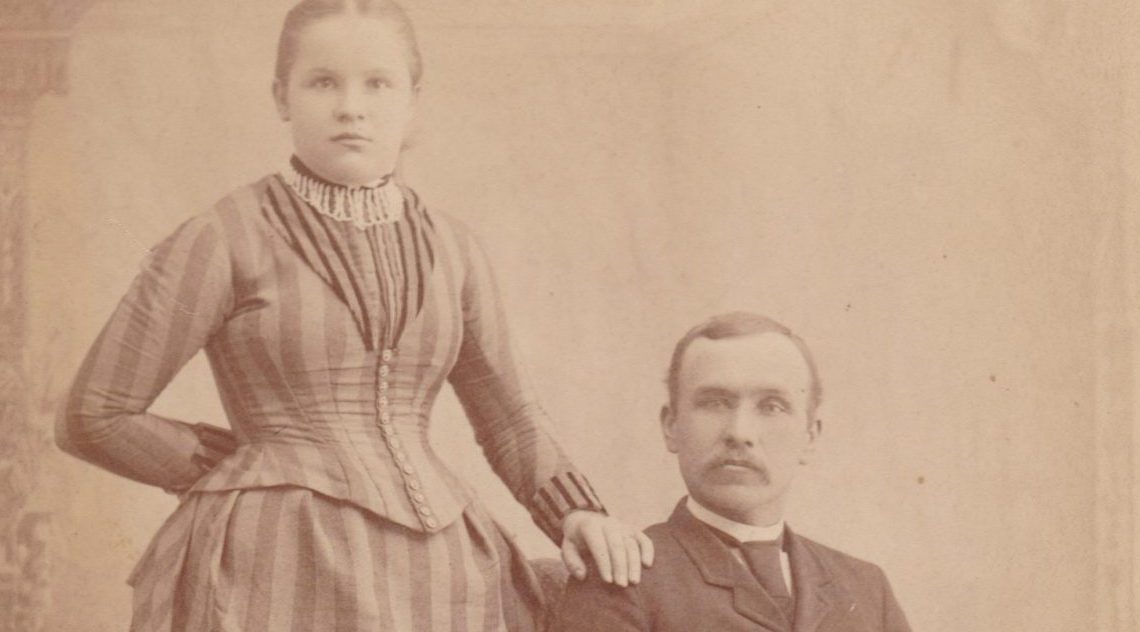Literature evangelism is a well-established tradition among Seventh-day Adventists and a rite-of-passage for many students in need of summer employment. But this has not always been the case.
When my Swedish-born great-great-great-grandfather, Hans Ed Hanson*, took his first step toward joining the Adventist Church in 1876, there were no literature evangelists, more commonly known as colporteurs or canvassers back in the day. Pioneering Adventist literature evangelist George King had yet to demonstrate the effectiveness of this outreach method. Thus, in recently perusing Grandpa Hanson’s memoir written for his family in 1925 when he was seventy-years old, it dawned on me that he was one of the first colporteurs, perhaps the very first, to work in the Swedish community in western Michigan. In his own words, “Selling religious books by subscription was unknown before [George King], and, so far as I know, selling subscription books to the Scandinavians was unknown before the Review and Herald commenced selling Kellogg’s little [Home] handbook in Swedish.”
Hanson was born on August 29, 1855, in Gnarp, Sweden, seven miles west of the Gulf of Bothenia. He immigrated to the United States with his parents and younger sister in 1868. Unlike so many immigrants of the time who settled on farms on the Great Plains, the Hansons moved to Grand Rapids, Michigan, where Hanson’s father found work with the railroad. In the early 1870s, the family settled in the Swedish immigrant neighborhood of Whitehall, Muskegon County, Michigan, where Hanson and his father worked in the lumber mills. The Hansons attended the Scandinavian Lutheran Church where Hans Ed was confirmed, probably in 1871. In his memoirs, he said he was confirmed when he was about eighteen, which would have been 1873-1874; however, he also said he was confirmed in the old church building a year before the new Swedish Lebanon Lutheran Church was built. That structure was built in 1872.
By the time the Advent Review and Sabbath Herald announced in April 1874 that John Byington would be visiting Whitehall, Adventism had already been introduced to the area. Hanson states that, “in a year or so [after the Lebanon Lutheran Church was built] an Adventist came through Whitehall and distributed Swedish tracts and copies of the Advent Herald in Swedish.” Byington visited the area again in 1875, meeting with Adventists in Oceana County “near Greenwood Station” and attending the funeral of Frank Wiard’s infant on the shore of White Lake (Whitehall and Montague are the towns on either side of the lake). Hanson never mentions Byington in his memoir, but he met regularly with the Wiards and their fellow Adventists, the Christophersons, so it is entirely possible he also met Byington.
The Hanson family’s journey to Adventism was long and slow. It was not until 1876 that Hanson made a decision to begin keeping the seventh-day Sabbath. Over the next several years, he attended a Bible study group at the Donnelson Schoolhouse in Hart, Michigan, that studied first, Thoughts on Revelation by Uriah Smith, and then, Bell’s Progressive Bible Lessons. He visited a group of Adventists who met at the G. W. Newman farm in Shelby, Michigan, as frequently as possible and was present when the Shelby church was organized in the late 1870s, although he was not invited to join because he still lived in Whitehall. He did become a member of this church around 1883.
The Whitehall area received much attention from Adventist Bible workers and evangelists in the late 1870s. In 1877 and 1878, Gustaf A. Carlstedt visited interested Swedish and Danish families at least twice. Elbert B. Lane and his wife Ellen visited churches in the area a year before Elder Lane’s death in 1881. This may have been when they conducted the meetings in Montague mentioned by Hanson. Ellen Lane continued to work in the area, sometimes collaborating with E. P. Daniels. (Ellen Lane held a ministerial license until 1889, but as a woman was never ordained. Although a highly effective minister, she was never allowed to baptize converts or organize new churches.)
In his memoirs, Hanson does not state whether his parents and sister joined him in his spiritual journey. But a note in the Evangelical Lutheran Church in America’s Swedish American Church Records indicates the family was excommunicated around 1879. When an Adventist church was organized in Whitehall’s twin city of Montague (on the opposite shore of White Lake) by E. P. Daniels, Hanson joined this congregation. But he seldom attended either Montague or Shelby during these years, having already taken up colporteuring.
A Colporteur’s Life
We cannot be certain of the precise time Hanson began selling Adventist books. He simply integrates his experience with the history of his road to Adventism. The first title he sold was Dr. John Harvey Kellogg’s The Home Hand-Book of Domestic Hygiene and Rational Medicine, first printed in Swedish in 1882. Hanson sold about 700 copies in all, starting with 75 books in Whitehall, then moving to Swedish neighborhoods in Muskegon, Ishpeming, Negaunee, Marquette, and Cadillac (all in Michigan), and across Lake Michigan to Rockford, Illinois. He then repeated his path, selling Sunshine at Home (a book for children first published in 1883), Uriah Smith’s Thoughts on Daniel and the Revelation (Swedish edition, 1886; Danish edition, 1887), and Ellen White’s Life of Christ (Danish edition, 1885).
Colporteuring in the early days was not for the faint of heart. It required travel under rugged and uncertain conditions to collect orders (subscriptions). Then a return journey to deliver the orders. If for any reason the customer was unhappy and refused payment, the colporteur was left with the bill. Colporteurs were personally responsible for the cost of the books. In Hanson’s words:
When we see the volume of the business of the subscription book work done with denominational books now, we perhaps do not realize the humble start it had or how it came about. The matter of credit was one point that the early would-be-bookseller had to face. The Review and Herald publishing house was furnishing the book direct, and the agent had to buy them. The church at Wright [Michigan] failed to recommend one J. W. S. Miller who, with a large list of orders, had all kinds of trouble in getting his books and lost a large part from not being in time with the filling of his orders.
We all did our best to overcome hindrances. I had it about as easy as anyone. We all believed we were doing a God appointed work to prepare the way of the Lord with the printed page. I sold several hundred of Thoughts [on Daniel and the Revelation] and other large books. While doing this I spent the winters in Battle Creek at school taking such studies as would make me a better canvasser and to make me understand and explain the Bible.
By 1888, Hanson had decided to leave colporteur work. On October 14 of that year, he married Bertha Marcella Davey whose family joined the Adventist church in Shelby around 1885 due to the efforts of Ellen Lane. The newlyweds farmed alongside members of Bertha’s very large family and raised their own family of five children, four of whom survived to adulthood. Their descendants continue to serve the Adventist church to the sixth and seventh generations.
*My third great-grandfather’s name remains something of a mystery to this day. In Lutheran Church records, he is listed as Hans Erik. But in all other records his given name is Hans, Hans E. or Edward. Within family lore, he is always referred to as Hans Ed. His wife reported his name as Edward Hanson on his death certificate.










